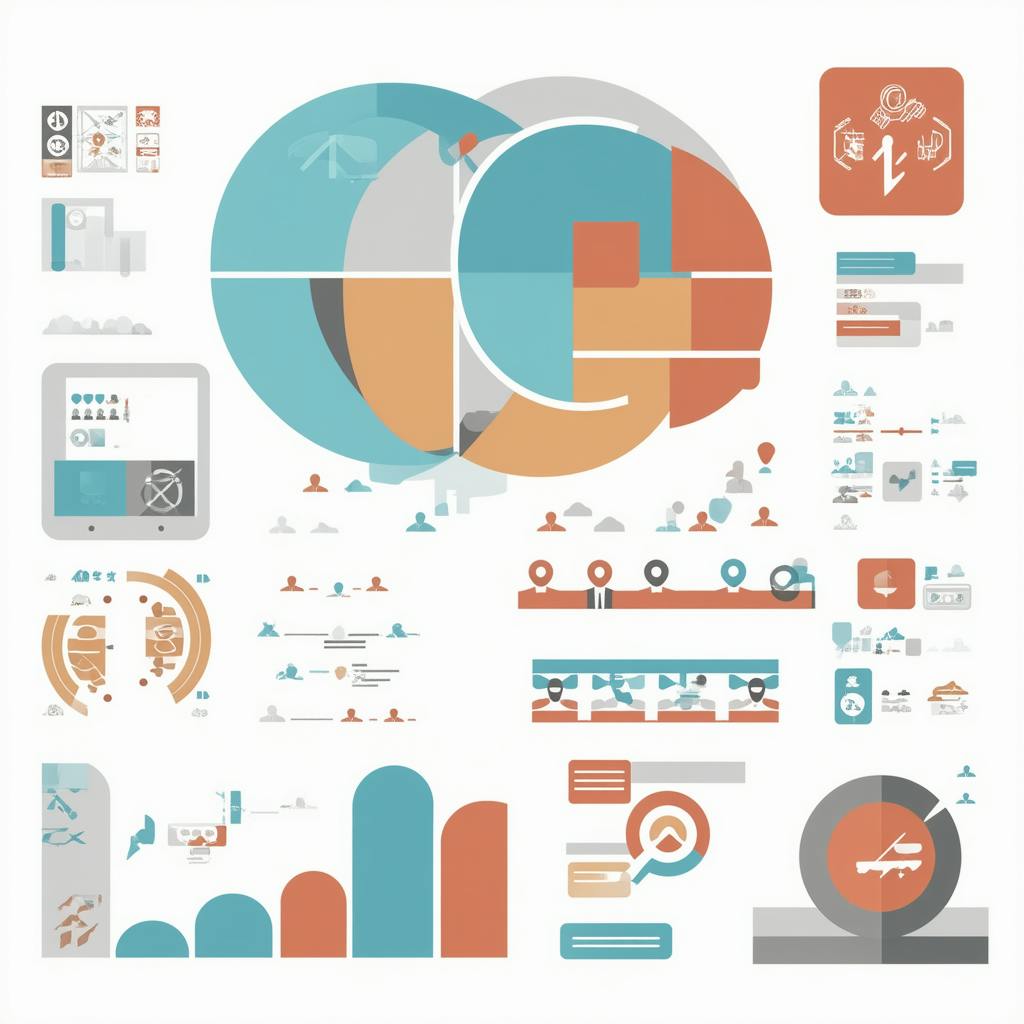Professional infographics have emerged as a powerful tool for transforming complex data into visually compelling narratives. With their ability to distill information into easily digestible visual forms, professional infographics help businesses, educators, and communicators convey messages more effectively to diverse audiences. This article explores the key elements of creating a successful professional infographic, using the framework of the 5Ws and H—Who, What, When, Where, Why, and How—to guide you through the process.
Who Uses Professional Infographics?
Professional infographics are utilized by a wide array of individuals and organizations, from marketing professionals and educators to data analysts and journalists. Any entity that needs to transmit a large amount of data in a clear and engaging manner can benefit from infographics. Whether it's showcasing research findings, illustrating educational content, or presenting business reports, infographics can significantly enhance comprehension and retention of information.
What is a Professional Infographic?
A professional infographic is an artful combination of data visualization, textual content, and graphic design that presents information in an aesthetically pleasing and engaging manner. Unlike simple graphs or charts, professional infographics integrate various elements to tell a story. They often include icons, illustrations, and comprehensive color schemes to capture the viewer's attention. For instance, a well-crafted infographic sample might effectively illustrate a company's quarterly achievements or outline complex processes in a visually intuitive way.

AI made with Stephanie Jagiello
When Should You Use an Infographic?
Understanding the right time to use an infographic is as crucial as the content itself. Infographics are particularly beneficial when you need to:
- Simplify complex information
- Make data more engaging
- Share information quickly
- Summarize extensive reports or studies
- Educate and inform a broad audience
Whether it's an annual report released at the end of a fiscal year or an educational infographic introduced at the start of a curriculum, timing plays an essential role in maximizing the impact of your visual content.
Where Can You Use Infographics?
Infographics are versatile and can be used across various platforms, making them an invaluable tool in today's digital landscape. They are often featured in blog posts, social media, newsletters, presentations, and even print media. Infographics enable you to reach your audience where they are most active, enhancing visibility and engagement.
Why Choose Professional Infographics?
The primary reason for opting for professional infographics is their ability to simplify the communication of complex information. In a world overwhelmed by data, infographics provide clarity and focus. They reduce cognitive load, making it easier for audiences to understand and retain information. Infographics examples from leading companies demonstrate the increased attention and engagement that visuals can draw compared to text-heavy documents. Their professional quality also enhances brand reputation, signaling a commitment to effective communication and innovation.
How to Create a Perfect Professional Infographic
Creating a professional infographic requires a thoughtful approach and attention to detail. Here are the steps to craft an effective infographic:
- Define Your Purpose and Audience: Understand the goal of your infographic and who will be viewing it. Tailor the content and design accordingly.
- Research and Gather Data: Accurate and relevant data is crucial. Ensure your information is up-to-date and credible.
- Choose the Right Tools: Use design software like Adobe Illustrator, Canva, or Piktochart that offers templates and easy-to-use design features.
- Plan the Layout and Flow: Organize your data logically, ensuring a seamless flow of information. The arrangement should guide the viewer's eye naturally across the infographic.
- Design with Clarity and Engagement in Mind: Utilize color, typography, and imagery to make the infographic both pleasing and informative. Remember minimalism is key—avoid clutter.
- Include a Call to Action if Needed: Direct viewers on what to do next after consuming the information, such as visiting a website or contacting a representative.
- Review and Revise: Before publishing, review the infographic for any errors or areas for improvement. Feedback from peers can be invaluable in this phase.
Frequently Asked Questions About Creating Professional Infographics
What are the necessary steps to making a professional infographic?
Creating a professional infographic involves several structured steps:
- Define Your Objective: Clearly establish the goal of your infographic. Are you trying to inform, educate, or persuade? Understanding your purpose will guide your content and design choices.
- Understand Your Audience: Determine who your audience is and what interests them. Tailor your style, tone, and level of complexity to suit their preferences and knowledge level.
- Research and Gather Data: Compile accurate data from credible sources. Ensure your information is current, relevant, and supports your infographic's objectives.
- Create a Storyboard: Plan the flow of information. Determine how your data points will connect and what narrative or logical sequence they will follow.
- Choose a Suitable Template or Layout: Decide on a layout that matches the complexity of your data and the narrative structure. Common types include timelines, flowcharts, and comparison infographics.
- Design with Visual Hierarchy: Use size, color, and placement to guide the viewer’s eye through your infographic, emphasizing the most critical information.
- Select Your Visual Elements: Choose charts, icons, and graphics that clarify your data.
- Avoid clutter and ensure each element has a clear function.
- Refine Your Text: Use concise language and clear titles. Text should complement visuals, not overwhelm them.
- Review and Revise: Check for accuracy in your data, spelling errors, and design consistency. Gather feedback and make necessary adjustments.
- Publish and Promote: Share your completed infographic on appropriate platforms while optimizing it for its specific use, whether it’s print or digital.

AI made with Stephanie Jagiello
How can I make my data visually compelling in an infographic?
Making data visually compelling involves:
- Simplicity and Clarity: Strip your data to its essence. Use straightforward visualizations to emphasize the most significant points.
- Color Use: Use color strategically to highlight key data points or patterns. Maintain a balanced palette to avoid overwhelming the viewer.
- Choice of Visualizations: Select the right type of chart or graph for your data. Use bar charts for comparisons, line graphs for trends, and pie charts for proportions.
- Consistent Styling: Use a consistent style for icons, fonts, and colors to maintain a cohesive look.
- Whitespace: Effective use of whitespace prevents the design from feeling cluttered and helps guide the viewer through the infographic.
- Interactivity: If digital, incorporate interactive elements that allow viewers to explore datasets in more depth.
What are the best tools to use for creating professional infographics?
There are a variety of tools available, depending on your level of expertise and requirements:
- Adobe Illustrator: Ideal for experienced designers, offering full creative control, precision, and customization.
- Canva: User-friendly with plenty of templates and elements, suitable for beginners or quick projects.
- Piktochart: Offers specialized templates and options tailored for infographic creation, suitable for intermediate users.
- Venngage: Provides a broad range of templates and easy-to-use design tools, ideal for varying skill levels.
- Infogram: Offers tools for creating interactive infographics, making it ideal for digital-focused projects.
What key elements should be included in a professional infographic?
A professional infographic should include:
- Headline: A clear, engaging title that summarizes the infographic's topic.
- Introductory Section: Briefly sets the context or purpose of the infographic.
- Key Data Points: The main information you aim to communicate, supported by valid data.
- Visual Representations: Charts, graphs, and icons that translate data into visual formats.
- Call-to-Action (if applicable): Encourages viewers to take further steps, whether it's learning more, contacting your organization, or taking action.
- Source Attribution: Lists sources of data and any third-party resources used, ensuring credibility.
- Branding Elements: Incorporates logos or brand colors to align the infographic with your brand identity.
By adhering to these guidelines, you can create a compelling, professional infographic that effectively communicates your data.
In conclusion, professional infographics are an essential tool for anyone looking to make data visually compelling and accessible. By using thoughtful design, clear data visualization, and precise communication, professional infographics can transform complex data into meaningful stories. As digital communication continues to evolve, mastering the art of creating professional infographics will undoubtedly give communicators an edge in conveying their messages effectively

